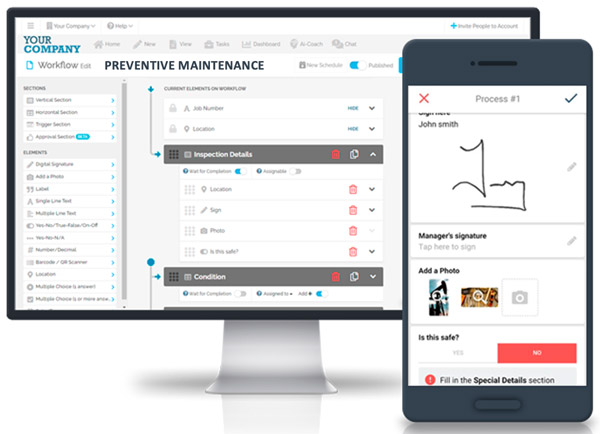The oil and gas industry is a complex sector that relies heavily on various types of assets to ensure smooth operations. These assets can be broadly categorized into two types: fixed assets and mobile assets. Understanding the difference between these two types of assets is crucial for effective asset management, which is where FAT FINGER, a digital workflow procedure builder, comes into play. In this article, we will delve into the differences between fixed and mobile assets in the oil and gas industry and how FAT FINGER can help manage these assets more efficiently.
What are Fixed Assets?
Fixed assets, also known as non-current assets, are long-term tangible pieces of property or equipment that a company owns and uses in its operations to generate income. In the context of the oil and gas industry, fixed assets typically include:
- Oil and gas wells
- Pipelines
- Refineries
- Storage tanks
These assets are ‘fixed’ in the sense that they are not easily converted into cash and cannot be quickly moved or replaced without disrupting the company’s operations.
What are Mobile Assets?
On the other hand, mobile assets are movable assets that are not tied to a specific location. They are often critical to the operations of the oil and gas industry and include:
- Drilling rigs
- Service trucks
- Heavy machinery
- Portable storage units
These assets are ‘mobile’ because they can be easily moved from one location to another as needed, providing flexibility in operations.
8 Differences Between Fixed and Mobile Assets in Oil and Gas
Fixed and mobile assets in the oil and gas industry have various differences that impact their use, management, and value. Understanding these differences is crucial for individuals and organizations involved in the industry.
1. Definition and Nature: Fixed assets are physical resources that are stationary and cannot be moved from one location to another. These include oil wells, processing facilities, pipelines, and storage tanks. On the other hand, mobile assets in the oil and gas industry are movable and can be transported from one location to another. These include drilling rigs, service trucks, and other equipment used in exploration and extraction.
2. Depreciation: Fixed assets typically have a longer lifespan and depreciate over a more extended period. The value of these assets reduces over time due to wear and tear and obsolescence. On the contrary, mobile assets might depreciate faster due to their frequent use and movement, which can lead to wear and tear.
3. Maintenance: Maintenance practices for fixed and mobile assets differ significantly. Fixed assets require scheduled, preventative maintenance to ensure they remain operational over their lifespan. Mobile assets, due to their constant use and movement, often require more frequent and extensive maintenance.

4. Capital Expenditure: Fixed assets usually require a higher capital expenditure due to their size and complexity. This includes the cost of purchase, installation, and commissioning. In contrast, mobile assets generally have lower initial costs but might incur higher operational costs due to their need for transportation and regular maintenance.
5. Asset Tracking: Tracking fixed assets is generally straightforward as they are stationary. However, tracking mobile assets can be more challenging since they frequently move between locations. This difference necessitates different asset management strategies for fixed and mobile assets.
6. Flexibility: Mobile assets provide more flexibility as they can be moved to different sites as needed. This is particularly useful in the oil and gas industry, where exploration and extraction activities might be spread across several locations. Fixed assets, on the other hand, are less flexible due to their immobility.

7. Risk Exposure: Mobile assets are exposed to a different set of risks compared to fixed assets. While fixed assets are mostly subject to operational risks such as equipment failure or process disruptions, mobile assets also face transportation-related risks, including accidents and damage during transit.
8. Regulatory Considerations: There might be different regulatory considerations for fixed and mobile assets. For instance, fixed assets such as processing facilities might be subject to environmental regulations. Mobile assets, meanwhile, might be subject to transportation and safety regulations.
In conclusion, fixed and mobile assets play critical roles in the oil and gas industry, but their differences in terms of nature, depreciation, maintenance, cost, tracking, flexibility, risk exposure, and regulatory considerations necessitate distinct strategies for their management and utilization
Managing Fixed and Mobile Assets with FAT FINGER
Effective asset management is crucial in the oil and gas industry to prevent unwanted breakdowns and ensure smooth operations. This is where FAT FINGER comes into play. With features like Drag & Drop Workflow Builder, Mobile & Desktop Workflows, Dashboards, Integrations, Augmented Reality, Connect IoT Devices, and Artificial Intelligence Coaching, FAT FINGER allows you to build mobile asset inspection workflows that help you easily and accurately monitor both fixed and mobile assets.

For instance, with FAT FINGER, you can schedule regular inspections for your fixed assets like pipelines and storage tanks, ensuring they are in optimal condition and reducing the risk of unexpected breakdowns. Similarly, for mobile assets like service trucks and drilling rigs, FAT FINGER allows you to track their location, usage, and condition in real-time, enabling proactive maintenance and efficient utilization.
Conclusion
In conclusion, understanding the difference between fixed and mobile assets in the oil and gas industry is crucial for effective asset management. While fixed assets form the infrastructure of the company and require regular maintenance, mobile assets provide operational flexibility and require dynamic management. With a solution like FAT FINGER, managing both these types of assets becomes a breeze, ensuring smooth operations and preventing unwanted breakdowns.
Ready to take your asset management to the next level? Request a demo of FAT FINGER today and see how our mobile asset inspection workflows can help you manage your assets more efficiently. Or better yet, create a mobile asset inspection workflow for free on FAT FINGER and experience the difference yourself!

